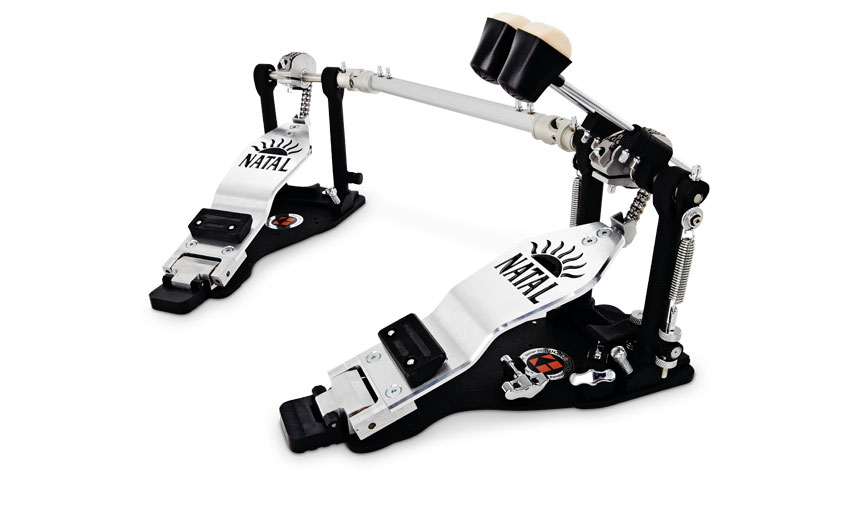MusicRadar Verdict
Having experimented with the various settings during the review, the pedals remain set pretty much as they arrived - they feel amazingly natural underfoot and perform beautifully with little compromise on the dilemma of power versus speed.
Pros
- +
Feel natural. Best of both worlds: power and speed.
Cons
- -
Not much.
MusicRadar's got your back
When one of the UK's most-respected pedal designers and the fastest growing drum and hardware manufacturer on the planet choose to team up, you can be sure of something rather special. The unique pedal design expertise of Bullet and Kitch, married to the efficient manufacturing and global distribution of Natal - which is now under the wing of the mighty Marshall - makes perfect sense.
Since it was acquired by Marshall in 2010, Natal has seen some incredibly rapid growth. Marshall is, of course, synonymous with those great walls of amplification. However, the late Jim Marshall was himself a drummer and keen to invest in the great British heritage of Natal, adding a drum line to the great Marshall name.
At one of the autumn drum shows, Natal expressed their interest in the Bullet and Kitch designs and the seeds of the partnership were sown. The official announcement took place at the recent NAMM show, where the early fruits of this unique partnership were aired to the public for the first time.
For this review though it's the turn of another newly designed model. Hot from the manufacturers, and literally a day before its inaugural visit to Musikmesse in Frankfurt, we give the double version of this spanking pedal an exclusive and thorough testing.
Build
"This captures many of the worthy features from each of the two original models"
This exciting hybrid is an amalgamation of a chassis and drive shaft from Natal's ProSeries double, together with the footplate of a Bullet & Kitch FB-007. This captures many of the worthy features from each of the two original models. From the ProSeries model these include the 'Ultra Fast' cam, self-levelling hoop clamp and a stainless steel bearing shaft which allows an infinitely adjustable beater angle.
Other notable aspects include the lower spring attachment, hinged to allow a smoother spring movement, while avoiding any unnecessary spring stretching. Memory locks are provided on both of the two dual-sided (felt/plastic) beaters - which also bear the Natal sun logo - and being a doubler, an interconnecting drive shaft. This robust steel shaft has a total of eight bearing sets that should help give the remote pedal a smooth and fast action.
Ultimately, it's the contoured aluminium Joggle Board pedals, with their intriguing plastic blocks, that gives them a wholly unique appearance. The 6mm thick aircraft-grade aluminium looks great in contrast to the powder-coated components of the base plate and bearing posts. Both footplates are fitted with adjustable, sliding 'control blocks', designed for the feet to pivot - acting as a foot fulcrum for the heel/ toe technique. Embossed on both footplates are the Natal logos and brand name.
Want all the hottest music and gear news, reviews, deals, features and more, direct to your inbox? Sign up here.
Hands On
With the foot of the pivoting rim clamp positioned between each of the two lower kick lugs, the main pedal is attached via the side-access clamp. Both beaters have their stems just protruding from the lower part of their individual clamps.
"The 'fast cam' helps rocket the beaters, accelerating them until they each slam onto the bass drum head"
For the first trial, the pedal is positioned/ set with a 'standard' flat footplate, with both beaters at their maximum length. The beater position means a slight trade-off between speed and power, but, within just a couple of stomps, the action - and indeed speed - impresses.
With a downward flick of our foot, the 'fast cam' helps rocket the beaters, accelerating them until they each slam onto the bass drum head. The pedal returns almost as rapidly and our feet produce a flurry of quick-fire wallops upon the bass drum - all good news.
Those familiar with this version of the Joggle Board will know the ease of adaptation from a standard pedal to the heel/toe action - just a quick flip of the rear-ended heel support is all that's required and the conversion is complete. This action can be returned back to a straight plate just as quickly, even in mid-performance, by lifting it with your foot, hinging it back to rest on the rear of the foot plate.
The principal of the heel/toe technique is that it allows the beater/s to strike twice for every downward movement of the foot. It is slightly misleading, in that it is actually the ball of the foot and the toes that do all the graft, and the heel simply drops downwards.
The area designated for the heel and each of the control blocks helps train the feet and the necessary muscle memory in order to master this technique quickly.
There are many advantages to learning a whole variety of techniques though - and this pedal will help you find the one that's right for you.
